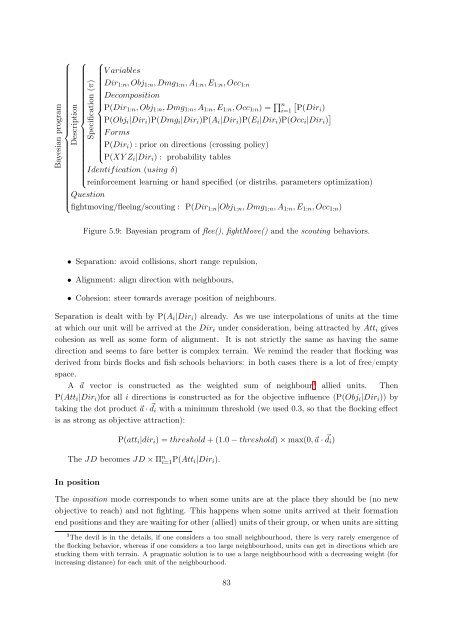Bayesian Programming and Learning for Multi-Player Video Games ...
Bayesian Programming and Learning for Multi-Player Video Games ...
Bayesian Programming and Learning for Multi-Player Video Games ...
You also want an ePaper? Increase the reach of your titles
YUMPU automatically turns print PDFs into web optimized ePapers that Google loves.
⎧⎪<br />
<strong>Bayesian</strong> program ⎨<br />
⎧⎪<br />
Description ⎨<br />
Specification (π)<br />
Identification (using δ)<br />
⎪⎩<br />
rein<strong>for</strong>cement learning or h<strong>and</strong> specified (or distribs. parameters optimization)<br />
Question<br />
⎪⎩<br />
⎧<br />
V ariables<br />
Dir1:n, Obj1:n, Dmg1:n, A1:n, E1:n, Occ1:n<br />
Decomposition<br />
⎪⎨<br />
P(Dir1:n, Obj1:n, Dmg1:n, A1:n, E1:n, Occ1:n) = �n �<br />
i=1 P(Diri)<br />
P(Obji|Diri)P(Dmgi|Diri)P(Ai|Diri)P(Ei|Diri)P(Occi|Diri) �<br />
F orms<br />
P(Diri) : prior on directions (crossing policy)<br />
⎪⎩<br />
P(XY Zi|Diri) : probability tables<br />
fightmoving/fleeing/scouting : P(Dir1:n|Obj1:n, Dmg1:n, A1:n, E1:n, Occ1:n)<br />
Figure 5.9: <strong>Bayesian</strong> program of flee(), fightMove() <strong>and</strong> the scouting behaviors.<br />
• Separation: avoid collisions, short range repulsion,<br />
• Alignment: align direction with neighbours,<br />
• Cohesion: steer towards average position of neighbours.<br />
Separation is dealt with by P(Ai|Diri) already. As we use interpolations of units at the time<br />
at which our unit will be arrived at the Diri under consideration, being attracted by Atti gives<br />
cohesion as well as some <strong>for</strong>m of alignment. It is not strictly the same as having the same<br />
direction <strong>and</strong> seems to fare better is complex terrain. We remind the reader that flocking was<br />
derived from birds flocks <strong>and</strong> fish schools behaviors: in both cases there is a lot of free/empty<br />
space.<br />
A �a vector is constructed as the weighted sum of neighbour 3 allied units. Then<br />
P(Atti|Diri)<strong>for</strong> all i directions is constructed as <strong>for</strong> the objective influence (P(Obji|Diri)) by<br />
taking the dot product �a · � di with a minimum threshold (we used 0.3, so that the flocking effect<br />
is as strong as objective attraction):<br />
P(atti|diri) = threshold + (1.0 − threshold) × max(0,�a · � di)<br />
The JD becomes JD × Π n i=1 P(Atti|Diri).<br />
In position<br />
The inposition mode corresponds to when some units are at the place they should be (no new<br />
objective to reach) <strong>and</strong> not fighting. This happens when some units arrived at their <strong>for</strong>mation<br />
end positions <strong>and</strong> they are waiting <strong>for</strong> other (allied) units of their group, or when units are sitting<br />
3 The devil is in the details, if one considers a too small neighbourhood, there is very rarely emergence of<br />
the flocking behavior, whereas if one considers a too large neighbourhood, units can get in directions which are<br />
stucking them with terrain. A pragmatic solution is to use a large neighbourhood with a decreasing weight (<strong>for</strong><br />
increasing distance) <strong>for</strong> each unit of the neighbourhood.<br />
83


